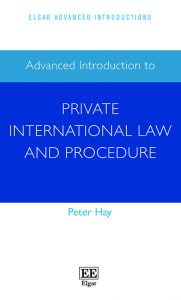Advanced Introduction to Private International Law and Procedure
 Peter Hay (Emory University, School of Law, USA) has recently published a new book on Private International Law and Procedure. Published in the Elgar Advanced Introduction Series the author has kindly provided the following (extended) summary:
Peter Hay (Emory University, School of Law, USA) has recently published a new book on Private International Law and Procedure. Published in the Elgar Advanced Introduction Series the author has kindly provided the following (extended) summary:
This book deals with the problems that arise in international litigation in civil and commercial cases. Some are familiar problems – for instance, when does a court have jurisdiction over an out-of-state defendant? – except that the international context adds complexity. Other problems are unique to the settlement of international disputes, for instance, does another country’s law apply to the substance of the case and how does one get a domestic judgment recognized and enforced in a foreign country?
The presentation is problem-oriented and takes a comparative-law approach. The three parts of the book present the principal problems parties face in dealing with cases with an international dimension. The latter may be either parties in different countries dealing with each other or facts or elements of the case that involve more than the state where suit is brought (the forum state).
There are no international law solutions to these problems, despite the name of the subject of this advanced introduction. “Private International Law” is the national law of each country dealing with international cases involving private law subject matters. Answers to the litigation problems identified and discussed in the text may therefore differ somewhat or substantially depending on the national law lens through which these problems are viewed. For this reason, this volume uses a comparative approach.
There are, of course, many nuances in the national laws around the world (see the Encyclopedia of Private International Law). But two main “systems” (again with differences within each) stand out, at least in the Western world: the civil law system, derived and developed from Roman law, which is the basis of much of European, South American and some other law, and the common law that spread from England to the United States, Canada and the British Commonwealth. To narrow things down, this volume compares – in the main, but not exclusively – the law of the European Union as largely representative of civil-law solutions and the approaches followed in the United States for the common law.
It would be a vast, indeed misleading overstatement to say that the systems show evidence of converging. Nonetheless, and with problems and the need for solutions being similar, some solutions do resemble each other. As the Conclusion suggests, European law has made particular strides in evolving a modern Conflicts law, in some respects adopting some of the flexibility that characterizes American law, but doing this in a circumspect and very principled way. Work on a new Restatement in the United States and beginning work in the Hague Conference on Private International Law on a new effort to come up with a multilateral convention on jurisdiction and judgment recognition may result in significant developments in the not too distant future.


